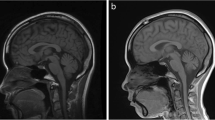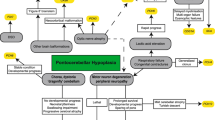Abstract
Pontocerebellar hypoplasia (PCH) is a heterogeneous group of disorders characterized by abnormally small cerebellum and brainstem. Recently a rare, novel form of PCH has been reported called cerebellar atrophy with progressive microcephaly (CLAM). Here we report a second family of CLAM with additional phenotypic features and novel molecular findings. Three-year old index patient had severe developmental delay and presented with short stature and microcephaly. Her cranial magnetic resonance imaging revealed hypoplasia of the cerebellum, brainstem and cerebrum associated with hypoplasia of the corpus callosum. Brainstem auditory evoked potentials revealed hearing loss and visual evoked potentials confirmed the optic atrophy. She also had seizures with two posterior epileptic foci on electroencephalogram. Molecular analysis revealed a homozygous haplotype between the markers D7S802 and D7S630 within the originally linked region, narrowing the critical region from 20 Mb to 7 Mb. Two highly relevant candidate genes, CROT and SLC25A40 located in this region were sequenced, but no causative mutations identified. Our case provides additional clinical characteristics on the previously described features of this new entity, and reducing the critical region will now allow systematic positional cloning efforts to identify the causative gene.
Similar content being viewed by others
References
Barth PG (1993) Pontocerebellar hypoplasias. An overview of a group of inherited neurodegenerative disorders with fetal onset. Brain Dev 15:411–422
Chou SM, Gilbert EF, Chun RW, Laxova R, Tuffli GA, Sufit RL, Krassikot N (1990) Infantile olivopontocerebellar atrophy with spinal muscular atrophy (infantile OPCA + SMA). Clin Neuropathol 9:21–32
Coppola G, Muras I, Pascotto A (2000) Pontocerebellar hypoplasia type 2 (PCH2): report of two siblings. Brain Dev 22:188–192
Dilber E, Aynaci FM, Ahmetoglu A (2002) Pontocerebellar hypoplasia in two siblings with dysmorphic features. J Child Neurol 17:64–66
Haitina T, Lindblom J, Renström T, Fredriksson R (2006) Fourteen novel human members of mitochondrial solute carrier family 25 (SLC25) widely expressed in the central nervous system. Genomics 88:779–790
Malandrini A, Palmeri S, Villanova M, Parrotta E, Sicurelli F, Amato D, DeFalco D, Guazzi GC (1997) A syndrome of autosomal recessive pontocerebellar hypoplasia with white matter abnormalities and protracted course in two brothers. Brain Dev 19:209–211
Rajab A, Mochida GH, Hill A, Ganesh V, Bodell A, Riaz A, Grant PE, Shugart YY, Walsh CA (2003) A novel form of pontocerebellar hypoplasia maps to chromosome 7q11-21. Neurology 60:1664–1667
Rudnik-Schöneborn S, Sztriha L, Aithala GR, Houge G, Laegreid LM, Seeger J, Huppke M, Wirth B, Zerres K (2003) Extended phenotype of pontocerebellar hypoplasia with infantile spinal muscular atrophy. Am J Med Genet A 117:10–17
Uhl M, Pawlik H, Laubenberger J, Darge K, Baborie A, Korinthenberg R, Langer M (1998) MR findings in pontocerebellar hypoplasia. Pediatr Radiol 28:547–551
van der Leij FR, Huijkman NC, Boomsma C, Kuipers JR, Bartelds B (2000) Genomics of the human carnitine acyltransferase genes. Mol Genet Metab 71:139–153
Zelnik N, Dobyns WB, Forem SL, Kolodny EH (1996) Congenital pontocerebellar atrophy in three patients: clinical, radiologic and etiologic considerations. Neuroradiology 38:684–687
Author information
Authors and Affiliations
Corresponding author
Rights and permissions
About this article
Cite this article
Durmaz, B., Wollnik, B., Cogulu, O. et al. Pontocerebellar hypoplasia type III (CLAM): Extended phenotype and novel molecular findings. J Neurol 256, 416–419 (2009). https://doi.org/10.1007/s00415-009-0094-0
Received:
Revised:
Accepted:
Published:
Issue Date:
DOI: https://doi.org/10.1007/s00415-009-0094-0




